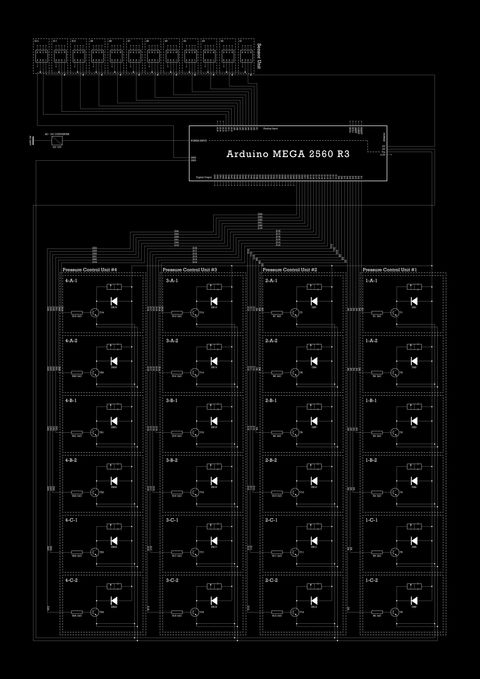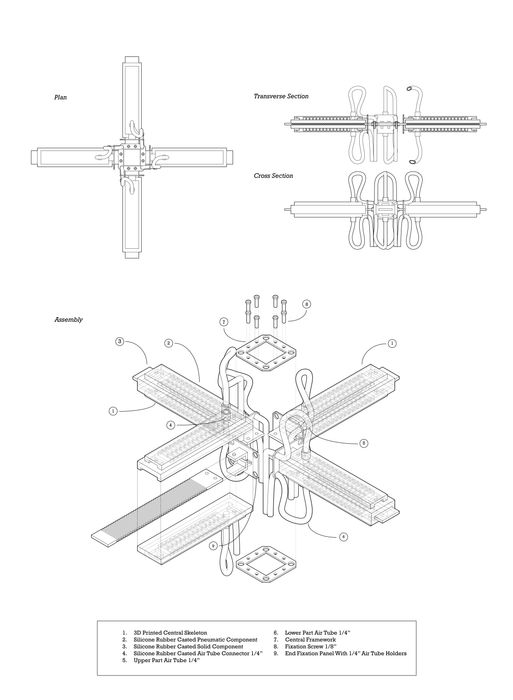
P.A.M.
Kinetic Architecture | Architectural Robot
Overview
The Post-Anthropocene Machines (P.A.M.) is an architectural hypothesis of an architectural machine that neglects human control and user comfort, contrary to the humanistic standard of contemporary design.
My Role
Designer in a duo team. This is the undergraduate thesis project in Syracuse University School of Architecture, collaborated with Zheng Fang, my peer and design partner.
Timeline
9 months
Thesis Research


"Certain dualisms have been persistent in Western traditions {...} self/other, mind/body, culture/nature, {...} agent/resource, maker/made, active/passive {...} High-tech culture challenges these dualisms in Intriguing ways."
-- Donna J. Haraway
Softness Study #1: Origami
Origami showcases its mathematical beauty through a balance of structural rigidity and mechanical flexibility. The angles of creases dictate folding directions and influence structural rigidity. Origami designs span various shapes, including planar, spiral, and dome shapes, offering vast potential in robotic design and form-finding applications.

Component Assembly
The actuation system comprises an Arduino MEGA 2560 R3, four breadboards, 24 pneumatic solenoid valves, one air compressor, and multiple air pressure sensors. Each sensor unit is linked to the actuation of pneumatic valve for each individual pneumatic silicone rubber compartment, achieving a decentralized movement control for more random results.
Each pneumatic component is connected to an air pressure sensor, in this case, to enable the P.A.M. machines to respond to the change in air flows and air pressures. After setting the trigger threshold of the air pressure level, the change in air pressure will trigger the air pumping in or out of the pneumatic components, causing the kinetic motion of the machine.
Research Studies: Architectural Softness

Thank You!
Softness Study #3: 3D Printing
Similar to the flexible wood cutting technique, the 3D printed parts, even with rigid material, can be flexible and bendable with the right thickness, helping us explore the impact of rigidity and softness with different formations of groove patterns.




Softness Study #4: Pneumatic Parts
The central part of the research is pneumatic components, which can be used as an actuator mechanism for the kinetic motion of the machine.

Design Studies: Post-Anthropocene Machine
Project Thesis
The concept of machine has profoundly influenced architectural design, prioritizing functionality, efficiency, and economy. However, the traditional 'form follows function' paradigm overlooks the machine's potential to reinterpret and reshape human-environment relationships. This thesis aims to explore the antithesis of machine and its broader humanist aspirations. Machines, as autonomous agents, go beyond mere responsiveness, offering a sensuous cohabitation between humans, the environment, and the machine itself.
As cogently argued by Haraway and numerous other authors, the emergence of a posthuman continuum, facilitated by smart materials, machine learning, and indeterminate systems, challenges our traditional view of architecture as solely human-centric. This prompts us to ask: For whom is architecture designed, and how can it integrate into what Haraway refers to as the "messy contingencies, material ambiguities, and heterogeneous audiences" within our environment?
The post-human condition is our current reality, demanding in-depth exploration of autonomous technologies. This exploration will enable us to view architecture not as a product of disciplinary confines, but as an entity that interacts with environmental forces through contextual, embedded, formal, spatial, and experiential studies. The environment has never been neutral; it has always been teeming with hybrids in a constant state of becoming.
Post-Anthropocene Machines
The family of Post-Anthropocene Machines represented a series of explorations of how kinetic movement impact the spatial property of its surroundings and shed light onto the possibilities of repurposing architectural space or architectural components for a more consensual and symbiotic relationship between human/non-human and architecture.
"The softness of the Apollo spacesuit is indicative of a special afinity between the bodies of Apollo’s astronauts and the spacesuits that protected them {...}. As such, their iconic image should project not a mastery of nature through technology, but rather a necessary sympathy to those parts of nature that, like our own bodies, defy easy systemization."
-- Nicholas de Monchaux

Softness Study #2: Rigid Body
Inspired by the principles of robotic rigid body motion, the transforming pavilion comprises stable triangular parts and adaptable quadrilateral components. These elements regulate its movement, continuously reshaping the space beneath the canopy.

P.A.M. #1 Bending Pillars
P.A.M. #2 Arching Triangles
P.A.M. #3 Wiggling Canopy
P.A.M. #3 Wiggling Canopy - Arctic Scene



























